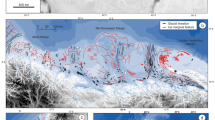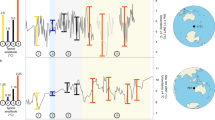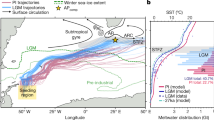Abstract
Deep sea geological records indicate that Antarctic ice-sheet growth and decay is strongly influenced by the Earth’s astronomical variations (known as Milankovitch cycles), and that the frequency of the glacial–interglacial cycles changes through time. Here we examine the emergence of a strong obliquity (axial tilt) control on Antarctic ice-sheet evolution during the Miocene by correlating the Antarctic margin geological records from 34 to 5 million years ago with a measure of obliquity sensitivity that compares the variance in deep sea sediment core oxygen-isotope data at obliquity timescales with variance of the calculated obliquity forcing. Our analysis reveals distinct phases of ice-sheet evolution and suggests the sensitivity to obliquity forcing increases when ice-sheet margins extend into marine environments. We propose that this occurs because obliquity-driven changes in the meridional temperature gradient affect the position and strength of the circum-Antarctic easterly flow and enhance (or reduce) ocean heat transport across the Antarctic continental margin. The influence of obliquity-driven changes in ocean dynamics is amplified when marine ice sheets are extensive, and sea ice is limited. Our reconstruction of the Antarctic ice-sheet history suggests that if sea-ice cover decreases in the coming decades, ocean-driven melting at the ice-sheet margin will be amplified.
This is a preview of subscription content, access via your institution
Access options
Access Nature and 54 other Nature Portfolio journals
Get Nature+, our best-value online-access subscription
$29.99 / 30 days
cancel any time
Subscribe to this journal
Receive 12 print issues and online access
$259.00 per year
only $21.58 per issue
Buy this article
- Purchase on Springer Link
- Instant access to full article PDF
Prices may be subject to local taxes which are calculated during checkout




Similar content being viewed by others
References
DeConto, R. M. & Pollard, D. Rapid Cenozoic glaciation of Antarctica induced by declining atmospheric CO2. Nature 421, 245–249 (2003).
Zhang, Y. G., Pagani, M., Liu, Z., Bohaty, S. M. & DeConto, R. A 40-million-year history of atmospheric CO2. Phil. Trans. R. Soc. 371, 20130096 (2013).
Lawver, L. A. & Gahagan, L. M. Evolution of Cenozoic seaways in the circum-Antarctic region. Palaeogeogr. Palaeoclimatol. Palaeoecol. 198, 11–37 (2003).
Williams, T. & Handwerger, D. A high‐resolution record of early Miocene Antarctic glacial history from ODP Site 1165, Prydz Bay. Paleoceanography 20, PA2017 (2005).
Galeotti, S. et al. Antarctic ice sheet variability across the Eocene–Oligocene boundary climate transition. Science 352, 76–80 (2016).
Naish, T. et al. Obliquity-paced Pliocene West Antarctic Ice Sheet oscillations. Nature 458, 322–328 (2009).
De Vleeschouwer, D., Vahlenkamp, M., Crucifix, M. & Pälike, H. Alternating Southern and Northern Hemisphere climate response to astronomical forcing during the past 35 m.y. Geology 45, 375–378 (2017).
Pälike, H. et al. The heartbeat of the Oligocene climate system. Science 314, 1894–1898 (2006).
Liebrand, D. et al. Cyclostratigraphy and eccentricity tuning of the early Oligocene through early Miocene (30.1–17.1 Ma): Cibicides mundulus stable oxygen and carbon isotope records from Walvis Ridge Site 1264. Earth Planet. Sci. Lett. 450, 392–405 (2016).
Holbourn, A., Kuhnt, W., Clemens, S., Prell, W. & Andersen, N. Middle to late Miocene stepwise climate cooling: evidence from a high-resolution deep water isotope curve spanning 8 million years. Paleoceanography 28, 688–699 (2013).
Laskar, J., Robutel, P., Gastineau, M., Correia, A. C. M. & Levrard, B. A long term numerical solution for the insolation quantities of the Earth. Astron. Astrophys. 428, 261–285 (2004).
Kominz, M. A., Miller, K. G., Browning, J. V., Katz, M. E. & Mountain, G. S. Miocene relative sea level on the New Jersey shallow continental shelf and coastal plain derived from one-dimensional backstripping: a case for both eustasy and epeirogeny. Geosphere 12, 1437–1456 (2016).
De Santis, L., Prato, S., Brancolini, G., Lovo, M. & Torelli, L. The eastern Ross Sea continental shelf during the Cenozoic: implications for the West Antarctic Ice Sheet development. Glob. Planet. Change 23, 173–196 (1999).
Sorlien, C. C. et al. Oligocene development of the West Antarctic Ice Sheet recorded in eastern Ross Sea strata. Geology 35, 467–470 (2007).
Bart, P. J. & De Santis, L. Glacial intensification during the Neogene: a review of seismic stratigraphic evidence from the Ross Sea, Antarctica, continental shelf. Oceanography 25, 166–183 (2012).
Levy, R. et al. Antarctic ice sheet sensitivity to atmospheric CO2 variations in the early to mid-Miocene. Proc. Natl Acad. Sci. USA 113, 3453–3458 (2016).
McKay, R. et al. The stratigraphic signature of the late Cenozoic Antarctic ice sheets in the Ross Embayment. Geol. Soc. Am. Bull. 121, 1537–1561 (2009).
Anderson, J. B. et al. Progressive Cenozoic cooling and the demise of Antarctica’s last refugium. Proc. Natl Acad. Sci. USA 108, 11356–11360 (2011).
Hambrey, M. J. et al. Cenozoic glacial record of the Prydz Bay continental shelf, East Antarctica. Proc. Ocean Drilling Program, Scientific Results 119, 77–132 (1991).
Florindo, F. et al. Magnetobiostratigraphic chronology and palaeoenvironmental history of Cenozoic sequences from ODP sites 1165 and 1166, Prydz Bay, Antarctica. Palaeogeogr. Palaeoclimatol. Palaeoecol. 198, 69–100 (2003).
Scher, H. D., Bohaty, S. M., Zachos, J. C. & Delaney, M. L. Two-stepping into the icehouse: East Antarctic weathering during progressive ice-sheet expansion at the Eocene–Oligocene transition. Geology 39, 383–386 (2011).
Barrett, P. J. Textural characteristics of Cenozoic preglacial and glacial sediments at Site 270, Ross Sea, Antarctica. Initial Rep. Deep Sea Drilling Project 28, 757–766 (1975).
Naish, T. R., Wilson, G. S., Dunbar, G. B. & Barrett, P. J. Constraining the amplitude of Late Oligocene bathymetric changes in western Ross Sea during orbitally-induced oscillations in the East Antarctic Ice Sheet: (2) implications for global sea-level changes. Palaeogeogr. Palaeoclimatol. Palaeoecol. 260, 66–76 (2008).
Zachos, J. C., Shackleton, N. J., Revenaugh, J. S., Pälike, H. & Flower, B. P. Climate response to orbital forcing across the Oligocene–Miocene boundary. Science 292, 274–278 (2001).
Beddow, H. M., Liebrand, D., Sluijs, A., Wade, B. S. & Lourens, L. J. Global change across the Oligocene–Miocene transition: high-resolution stable isotope records from IODP Site U1334 (equatorial Pacific Ocean). Paleoceanography 31, 81–97 (2016).
Crampton, J. S. et al. Southern Ocean phytoplankton turnover in response to stepwise Antarctic cooling over the past 15 million years. Proc. Natl Acad. Sci. USA 113, 6868–6873 (2016).
Sangiorgi, F. et al. Southern Ocean warming and Wilkes Land ice sheet retreat during the mid-Miocene. Nat. Commun. 9, 317 (2018).
Badger, M. P. S. et al. CO2 drawdown following the middle Miocene expansion of the Antarctic Ice Sheet. Paleoceanography 28, 42–53 (2013).
Lewis, A. R. et al. Mid-Miocene cooling and the extinction of tundra in continental Antarctica. Proc. Natl Acad. Sci. USA 105, 10676–10680 (2008).
Shepherd, A., Wingham, D. & Rignot, E. Warm ocean is eroding West Antarctic Ice Sheet. Geophys. Res. Lett. 31, L23402 (2004).
Hillenbrand, C.-D. et al. West Antarctic Ice Sheet retreat driven by Holocene warm water incursions. Nature 547, 43–48 (2017).
Golledge, N. R., Levy, R. H., McKay, R. M. & Naish, T. R. East Antarctic ice sheet most vulnerable to Weddell Sea warming. Geophys. Res. Lett. 44, 2343–2351 (2017).
DeConto, R. M. & Pollard, D. Contribution of Antarctica to past and future sea-level rise. Nature 531, 591–597 (2016).
Spence, P. et al. Rapid subsurface warming and circulation changes of Antarctic coastal waters by poleward shifting winds. Geophys. Res. Lett. 41, 4601–4610 (2014).
Stewart, A. L. & Thompson, A. F. Eddy-mediated transport of warm Circumpolar Deep Water across the Antarctic Shelf Break. Geophys. Res. Lett. 42, 432–440 (2014).
Timmermann, A. et al. Modeling obliquity and CO2 effects on Southern Hemisphere climate during the past 408 ka. J. Clim. 27, 1863–1875 (2014).
Toggweiler, J. R. & Russell, J. Ocean circulation in a warming climate. Nature 451, 286–288 (2008).
Pfuhl, H. A. & McCave, I. N. Evidence for late Oligocene establishment of the Antarctic Circumpolar Current. Earth. Planet. Sci. Lett. 235, 715–728 (2005).
Golledge, N. R. et al. The multi-millennial Antarctic commitment to future sea-level rise. Nature 526, 421–425 (2015).
Thomson, D. J. Spectrum estimation and harmonic analysis. Proc. IEEE 70, 1055–1096 (1982).
Meyers, S. R., Sageman, B. B. & Arthur, M. A. Obliquity forcing of organic matter accumulation during Oceanic Anoxic Event 2. Paleoceanography 27, PA3212 (2012).
Drury, A. J. et al. Deciphering the state of the late Miocene to early Pliocene equatorial Pacific. Paleoceanogr. Paleoclimatol. 33, 246–263 (2018).
Holbourn, A. E. et al. Late Miocene climate cooling and intensification of southeast Asian winter monsoon. Nat. Commun. 9, 1584 (2018).
Holbourn, A. et al. Middle Miocene climate cooling linked to intensification of eastern equatorial Pacific upwelling. Geology 42, 19–22 (2014).
R: A Language and Environment for Statistical Computing (R Foundation for Statistical Computing, 2016).
Meyers, S. R. Astrochron: an R package for Astrochronology (R Project for Statistical Computing, 2014).
Savage, M. L. & Ciesielski, P. F. in Antarctic Earth Science (eds Oliver, R. L., James, P. R. & Jago, J. B.) 555–559 (Australian Academy of Science, Canberra, 1983).
Florindo, F. et al. Paleomagnetism and biostratigraphy of sediments from Southern Ocean ODP Site 744 (southern Kerguelen Plateau): implications for early-to-middle Miocene climate in Antarctica. Glob. Planet. Change 110, 434–454 (2013).
Gradstein, F. M. et al. in The Geologic Time Scale (eds Gradstein, F. M., Ogg, J. G, Schmitz, D. & Ogg, M.) ix–xi (Elsevier, Amsterdam, 2012).
Raup, D. M. Mathematical models of cladogenesis. Paleobiology 11, 42–52 (1985).
Acknowledgements
This study was supported by the New Zealand Ministry of Business Innovation and Employment contract C05X1001 (R.H.L., T.R.N., N.R.G. and R.M.M.) and by NSF grant EAR-1151438 (S.R.M.). A sabbatical leave from the University of Wisconsin—Madison supported S.R.M to conduct research at the Institute of Geological and Nuclear Science.
Author information
Authors and Affiliations
Contributions
R.H.L. and S.R.M. conceived the project. R.H.L., T.R.N. and R.M.M. performed the stratigraphic and proxy synthesis, and S.R.M. conducted the time series analyses. R.H.L. and S.R.M. wrote the first draft of the manuscript, in consultation with T.R.N., N.R.G., J.S.C. and R.M.M. All the authors contributed to the interpretations and major findings of this work.
Corresponding author
Ethics declarations
Competing interests
The authors declare no competing interests.
Additional information
Publisher’s note: Springer Nature remains neutral with regard to jurisdictional claims in published maps and institutional affiliations.
Supplementary information
Supplementary Information
Supplementary Figures and Tables
Supplementary Data
Supplementary Data 1
Supplementary Data
Supplementary Data 2
Supplementary Data
R Script
Rights and permissions
About this article
Cite this article
Levy, R.H., Meyers, S.R., Naish, T.R. et al. Antarctic ice-sheet sensitivity to obliquity forcing enhanced through ocean connections. Nature Geosci 12, 132–137 (2019). https://doi.org/10.1038/s41561-018-0284-4
Received:
Accepted:
Published:
Issue Date:
DOI: https://doi.org/10.1038/s41561-018-0284-4
This article is cited by
-
The influence of subpolar marine ice expansion on global climate in the Early Pleistocene
npj Climate and Atmospheric Science (2024)
-
Large obliquity-paced Antarctic ice-volume fluctuations suggest melting by atmospheric and ocean warming during late Oligocene
Communications Earth & Environment (2023)
-
Reconciling Southern Ocean fronts equatorward migration with minor Antarctic ice volume change during Miocene cooling
Nature Communications (2023)
-
West Antarctic ice volume variability paced by obliquity until 400,000 years ago
Nature Geoscience (2023)
-
Climate-controlled submarine landslides on the Antarctic continental margin
Nature Communications (2023)



